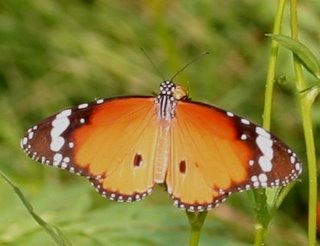More Tigers



Another common butterfly in Southeast Asia is the Plain Tiger. It is also in the danaidae family. It was particularly abundant in the Taipei Botanical Gardens when I was there in the end of October. It was very interesting because the Gardens has large pictures of the Common Tiger of which I didn't see any and no pictures of the Plain Tiger which was very common. Unlike the Common Tiger (see prior entries into this Blog), there is no special marking on the veins on either the the top or under surface of the wings. In one part of the Gardens, the Plain Tigers were abundant and I found one lonely Milkweed. It had not yet bloomed and it only had 10 leaves. I was curious as to whether any of the butterflies had laid any eggs. While every leaf did not have an egg, others had two and one leaf even had 3 eggs. In all, I counted a total of 10 eggs on this one plant. I am sure that there had to be other Milkweed elsewhere in the Gardens but in the couple of hours that I had available, I didn't locate them (I was too busy taking pictures of the butterflies that I did see). I am sure that when all the caterpillars emerge, more than a few will be disappointed and hungry.
Paul A. Levine





